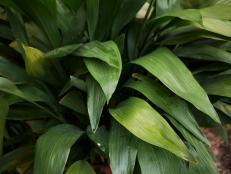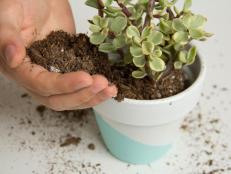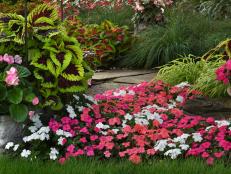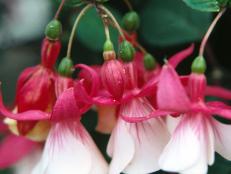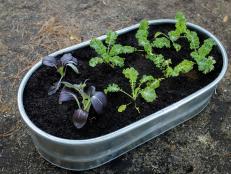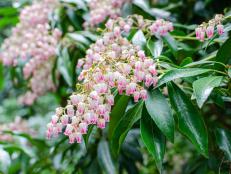Chaos Gardening: The Easiest Way to Grow a Garden
We're giving chaos gardening a green thumb's up. It's so easy and fun, you may decide to ditch the other garden styles you've tried.

Danilo Maffei, maffei landscape design, LLC
Let coneflowers (Echinacea purpurea) and Shenandoah switchgrass (Panicum virgatum 'Shenandoah') add color and movement to a chaos garden.

Have you ever groaned that you kill everything you plant? Try a gardening trend that's spreading like weeds, and you'll never have to dump your failures in the compost heap again.
Trendy chaos gardening is perfect for plant lovers who find gardening a tough row to hoe, and because it's simple, fun and affordable, it's great for gardeners who already have green thumbs. To date, this trend has had millions of views on TikTok, and even the prestigious Royal Horticultural Society Chelsea Flower Show included some chaos gardens in its 2023 displays.
What Is Chaos Gardening?
Don't let the word "chaos" fool you. It means "disorder," but that's not necessarily a bad thing. Chaos gardening lets Mother Nature take the lead, says Stephanie Rose, author of a dozen books, including
Garden Alchemy: 80 Recipes and Concoctions for Organic Fertilizers, Plant Elixirs, Potting Mixes, Pest Deterrents and More and The Regenerative Garden: 80 Practical Projects for Creating a Self-sustaining Garden Ecosystem.
It's about growing a garden that's a "little wild and crazy," says Stephanie, who also created Garden Therapy, a blog that covers herbalism, plant-based beauty recipes and more. Chaos gardening, she explains, is as simple and laid-back as taking handfuls of seeds and tossing them over the soil. Any seeds that don't have to be planted deeply will work, from flowers to edibles and annuals to perennials, and you can mix them up any way you want.
'Chaos' means, forget the rules. It's about taking back the land and gardens from what has been structured and high maintenance, like thirsty, manicured lawns and very landscaped environments.
Stephanie Rose, author of Garden Alchemy: 80 Recipes and Concoctions for Organic Fertilizers, Plant Elixirs, Potting Mixes, Pest Deterrents and More
At its root, chaos gardening means changing the way you think about gardening. "It's very freeing, especially to new gardeners," Stephanie says. "'Chaos' means, forget the rules. It's about taking back the land and gardens from what has been structured and high maintenance, like thirsty, manicured lawns and very landscaped environments."
How to Start Chaos Gardening
Don't make too many plans when you start a chaos garden, Stephanie says. "The more you plan, the more you take away from the beauty of the chaos. Just start and see how it goes. Any mistake is a learning experience." It's easy to simply scatter handfuls of seeds, or you can distribute them in pretty seed bombs. (Scroll down to find out how.)
If you're not sure which seeds to use, go to your local seed company and look at the blends for butterfly gardens, bee gardens, herb gardens or native wildflowers. Local garden centers know what will grow well in your area.
Scatter the seeds of sun-loving plants in sunny sites and the seeds of shade lovers in shady spots. If your soil doesn't hold moisture well, try the seeds of drought-tolerant plants. The size of your space doesn't matter. But be prepared: You won't get rows of veggies or flowers that march in nice, straight lines. Also, some seeds won't come up, and others may muscle out their neighbors, but that's fine. That's the point.

Stephanie Rose of Garden Therapy
For a butterfly-friendly chaos garden, remember to grow some host plants for their caterpillars. Welcome bees with a variety of plants that bloom throughout the growing season.
In a chaos garden, you don't have a clue about what's going to happen, Stephanie says, except that it's budget-friendly; seeds are cheaper than plants, and you can use leftover seeds from previous gardens.
"Mix some wildflower seeds, annuals and perennials and you'll get a nice bunch of coreopsis or echinacea, rudbeckias or other beautiful flowers that would cost $15 to $20 per pot at a nursery," Stephanie says.
You may have already chaos-gardened without realizing it. "Many a gardener has dumped out the mixed madness that was spilled in their seed storage," says Russell Taylor, VP of Live Earth Products, a Utah-based mining and manufacturing company. He sees chaos gardening as more intentional if you buy seeds to toss around. Since there are no rules to this gardening style, you can add live plants to your space, Stephanie says, or curate what comes up by moving your plants around — although true chaos gardening embraces a natural look.
Growing a Successful Chaos Garden
Although chaos gardening is perfect for even the laziest gardener, you can do a couple of things to help your seeds sprout and grow. (But only if you want to. Remember, this trend is about growing plants without rules or requirements.)
Russell says, "Your success rate will go way up if you improve your soil's organic matter" before you scatter your seeds. "Adding compost and humate helps build active and stable forms of organic matter to help conserve water and nutrients for the new plants." Humate, he explains, is "ancient, fully decomposed organic matter used to fast forward the soil building process. Think of humates as really old compost."
Russell points out that some plants can take over if left unchecked. "Before you go sowing seeds like Johnny Appleseed, take a look at their growth habits to make sure they are appropriate for that space." Also, check your HOA regulations to be sure your chaos garden won't grow too tall or unkempt or otherwise violate other local regulations.
Water your seeds lightly to get them started if there's no rain. "Keep the soil moist while germination is happening and the seedlings are young," Stephanie says. Perennials and self-sowing plants can keep the garden going year after year, and you can add to it. "What is strong enough to survive your natural conditions is chaos gardening."
Chaos gardens aren't for everyone, Stephanie says. Some people find them messy, but they're also beneficial. Planting a variety of seeds lets you grow a biodiverse garden with food and shelter for pollinators, birds and other wildlife.
Is Chaos Gardening the Same as Guerilla Gardening?
Not exactly. Guerilla gardeners usually toss seeds over the soil in public places, on private property, in vacant lots or in other unused areas. Their goal is to beautify a neglected spot, grow food, attract pollinators or otherwise benefit the environment. By definition, it's growing plants on land you don't own. That's trespassing, and it's illegal, even if you only throw seeds and never set foot on the property. Before you guerilla garden, get permission from the property owner and/or the local government or other authority.
Is a Chaos Garden the Same as a Cottage Garden?
Cottage gardens are informal, but they're thoughtfully and intentionally planted. They're often low maintenance, while chaos gardens are closer to no-maintenance unless you simply choose to do some transplanting, thinning or other garden task. While cottage gardens usually feature pansies, foxgloves and other old-fashioned favorites, chaos gardens include more modern types of herbs, vegetables, grasses and ornamentals.
How to Grow a Chaos Garden in Your Lawn
Tried of mowing and fertilizing your lawn? Skip the work and expense by replacing part of it with a chaos garden. Stephanie recommends doing some prep work first, so turfgrasses with strong roots won't compete with your seeds.
First, dig up the area you want to use. Flip the grass pieces over and cover them with a layer of cardboard or several layers of paper, she says, then "get them wet, top them with two or three inches of compost and plant right into it."
Stephanie's Tips for A Chaos Garden
- Group together plants that need the same basic amounts of light and water.
- Walk on your seeds after you toss them so they make good contact with the soil. This also helps keep the wind from blowing them away.
- Apply compost or fertilizer if desired.
- Scatter your seeds by hand or make seed bombs to throw over the soil. They'll shatter on impact or break down in the elements.
Tips for Growing Edibles in a Chaos Garden
Rebecca Sears, CMO and Resident Green Thumb at Ferry-Morse, recommends that cool-climate gardeners who want to grow and harvest edibles choose fast-growing veggie seeds that don't have to be planted deeply, like lettuce and basil. "For longer-to-maturity plants like tomatoes, eggplants and peppers, you're better off with traditional gardening methods like indoor seed starting and a planned garden bed."
BONUS: How to Make Clay-Based Seed Bombs
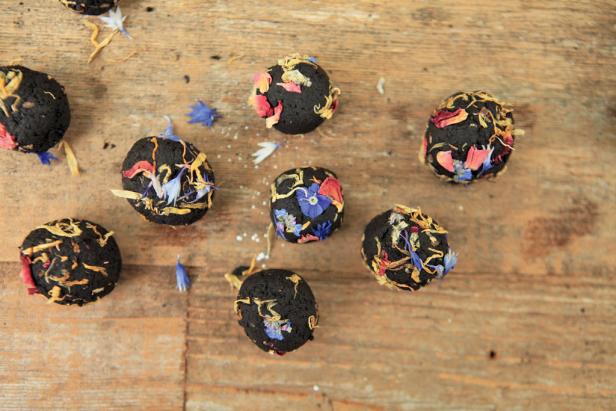
Stephanie Rose of Garden Therapy
Use a variety of seeds and dried flowers to make your seed bombs decorative. "Calendula seeds are curly, sunflowers have stripes, marigold seeds look like little porcupine quills and Centaurea seeds look like gold and gray rockets," Stephanie says.
Materials
- 5 parts finely screened homemade or purchased compost
- 1 part bentonite clay (or substitute another color of powdered clay)
- water
- seeds
Directions:
- Mix the compost with the bentonite clay. Add just enough water to hold them together.
- Roll the mixture between your palms to form compact balls with a pinch of seeds inside. Push big seeds into the middle of the balls.
- Optional: Roll the balls in dried flower petals or pretty seeds.
- Put the balls in a cool, dry place away from direct sunlight. When they're hard and no longer cool to the touch, they're ready to use.
The recipe is courtesy of Stephanie Rose.







